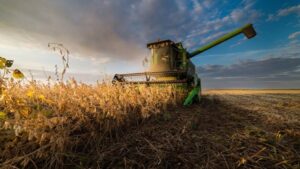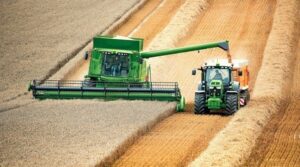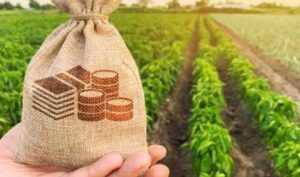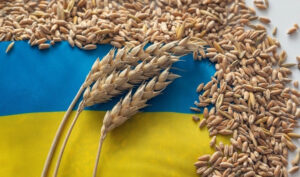
Borrowings from clients in the agricultural sector account for about 40% of the loan portfolio of the state-owned Ukrgasbank (Kyiv), said Mykola Alfyorov, deputy director of the small and medium business department of the financial institution.
“In general, 40% of our loan portfolio is made up of clients from the agricultural sector. This area will always be a priority, despite all the risks, as evidenced by the statistics of all banks,” he said at the Agro Finance Summit in Kyiv on Thursday.
According to him, in 2024 Ukrgasbank increased lending to the agricultural sector in the investment direction: it accounted for 50% of all loans. In total, since the beginning of the full-scale war, the bank has issued loans for almost UAH 10 billion.
“In the first year of the war, it was a task aimed at replenishing working capital and providing it to farmers so that they could sow and harvest on time. Already in 2023, we saw a dynamic increase in the investment interest of the agricultural sector, and in 2024 it was a real growth,” said Alfiorov.
Among the most popular financial products among agrarians, he named the state program “5-7-9%” in combination with international programs.
The Deputy Director of the Department also pointed out that Ukrgasbank actively provides financing up to UAH 8 million using guarantee mechanisms from farmers, but this amount can be doubled to UAH 16 million under a portfolio guarantee or a guarantee of an international organization.
According to the National Bank of Ukraine, as of November 1, 2024, Ukrgasbank ranked 5th (UAH 136.18 billion) among 62 banks operating in the country in terms of total assets. The net profit of the financial institution for 10 months of the year amounted to UAH 4.84 billion, while for the same period in 2023 it was UAH 3.36 billion.

On January 1, the Law “On Agricultural Notes” came into force in Ukraine, which provides for the establishment of a separate Register of Agricultural Notes.
It is expected that the register will contain information on the issuance, content and change of details of agrarian notes, termination and encumbrance of agrarian notes, and the commencement of enforcement of obligations under agrarian notes on the basis of a special extract from the register.
The Registry, in turn, will ensure transparency, efficiency and convenience of operations with agricultural notes by automating the processes of forming the details of agricultural notes, making changes, issuing and terminating them. Automated work will simplify the interaction between agricultural producers, creditors, and investors.
In addition, the digitalization of processes in the Registry will reduce transaction costs associated with the issuance and termination of agricultural notes, making the instrument cheap and easy to use.
Oleksiy Yudin, Chairman of the Board of the National Depository of Ukraine (NDU), previously expressed confidence that the project would be an important step in building the digital infrastructure of the agricultural sector, help attract additional investment and ensure sustainable economic growth.
“This project is an important step for the digitalization of the capital market and the agricultural sector in Ukraine. The development of the Agricultural Notes Register will not only help strengthen our country’s position in the global agricultural market, but also create new opportunities for investors,” said Ruslan Magomedov, Chairman of the National Securities and Stock Market Commission.
The NSSM added that this decision is an important infrastructure element and a central component of the entire ecosystem of agricultural notes, without which the full implementation of the new instrument in the market is impossible.
As reported, in October 2024, the International Finance Corporation (IFC, a member of the World Bank Group) and the National Depository of Ukraine signed a grant agreement under which NDU will receive up to $300 thousand to create and implement an innovative Register of Agricultural Notes.

In 2024, the Ukrainian agricultural sector set a second historical record of $24.5 billion in foreign exchange earnings from the export of agricultural products, Minister of Agrarian Policy and Food Vitaliy Koval said in an interview with Ukrainian Radio.
“To summarize the 24th year, it brought us the second best result in terms of foreign exchange earnings from exports. We set the second historical record – the country received $24.5 billion from the export of agricultural products. This is a good indicator,” he said.
The Minister recalled that the best year in terms of foreign exchange earnings from agricultural exports was 2021, when the agricultural sector earned $27.7 billion due to a good harvest.
Koval noted that compared to 2023, the agricultural sector’s foreign exchange earnings from exports increased by more than $2 billion.
“I think 2024 was a year of resilience for the entire agricultural sector. Ukrainian agrarians withstood, persevered and proved to be the best. The fact that we harvested a good crop, 75 million tons of grains and oilseeds, despite the mined land and hostilities is a good result, given that the year was dry and we had to admit the loss of yields. But in general, Ukraine has not only resisted, but also increased its agricultural power,” the Minister of Agrarian Policy summarized.

In 2025, the state budget of Ukraine will receive an additional UAH 5.2 billion from the agricultural sector at the expense of enterprises, institutions and organizations that are critical for the functioning of the economy, as well as due to an increase in the military tax rate, said Vitaliy Koval, Minister of Agrarian Policy and Food.
“I would like to thank the responsible agribusinesses that realize their key role in filling the budget of the country at war. Your patriotic stance and understanding bring us closer to victory,” the press service of the Ministry of Agrarian Policy and Food quoted him as saying.
The minister reminded that Law No. 4015-IX “On Amendments to the Tax Code of Ukraine and Other Laws of Ukraine on Ensuring the Balance of Budget Revenues during the Period of Martial Law” increased the military tax rate from 1.5% to 5.0%. Also, the Cabinet of Ministers Resolution No. 1332 provides for an increase in the accrued average salary of an employee applying for a reservation to 2.5 minimum wages (currently UAH 20 thousand – IF-U).
According to the Ministry of Agrarian Policy, additional revenues from such enterprises will amount to about UAH 1 billion.

The portfolio of loan agreements concluded by state-owned Oschadbank with agricultural, food and processing companies in the large corporate business segment has tripled during the war and as of October 1, 2024, reached UAH 9.9 billion compared to UAH 3.3 billion in 2021, Yuriy Katsiyon, Deputy Chairman of the Board of the bank in charge of corporate business, said in an interview with Interfax-Ukraine.
According to him, the volume of agreements concluded to support enterprises in these segments among Oschad’s corporate business clients in 2024 amounted to UAH 1.4 billion, or 20% of the total volume of agreements concluded during this period.
“We finance companies that have suffered from military aggression, such as Nibulon. We financed the first military sowing season, setting an example for all other banks to start lending. As a result, we more than doubled our corporate loan portfolio among agricultural, food and processing companies in the year from 2022 to 2023, from UAH 4 billion to UAH 8.8 billion. As of October 1, 2024, this corporate business portfolio reached UAH 9.9 billion,” he said.
Mr. Katsion also said that Oschad’s share in financing businesses in all industries has reached 14% of the total market, which is the second place among Ukrainian banks. In addition, Oschad ranks second among all legal entities in financing in the agricultural business segment and food production. These loans account for UAH 23.7 billion, or more than 15% of the financial institution’s portfolio.
The Deputy Chairman of the Board added that the volume of concluded loan agreements in the agrarian, food and processing industries, food trade in the segment of large corporate business in 2021 amounted to UAH 0.87 billion, in 2022 – UAH 4.6 billion, in 2023 – UAH 11 billion, and in 2024 – UAH 4 billion. In total, during the war, Oschad provided almost UAH 20 billion in loan agreements for corporate business.
The number of Oschad’s clients in this segment reached 15 business groups or 30 companies. At the same time, more than 80% of them started borrowing from the bank for the first time during the war.
“Since the beginning of 2023, we have increased our market share by 1.5 times. This year alone, the growth is 4%,” summarized the Oschadbank’s corporate business manager.
According to the financial institution, the top five banks in agricultural financing are as follows: Raiffeisen, Oschadbank, Ukreximbank, FUIB, and Credit Agricole Bank.
According to the National Bank of Ukraine, as of September 1, 2024, Oschadbank ranked 2nd (UAH 425.75 billion) in terms of total assets among 62 banks in the country. The financial institution’s net profit for the first eight months of this year amounted to UAH 11.18 billion.

Ukraine’s agricultural sector made a significant breakthrough in development in 2010-2021, employing 17% of Ukrainians and generating 19% of GDP, while 70% of its products are exported, which is one of the highest rates in Europe, said Acting Minister of Agrarian Policy and Food Taras Vysotsky.
According to him, Ukraine’s production is enough to feed almost 400 million people.
“Ukraine’s role in international food security is very important. After the full-scale invasion of the aggressor country, Ukraine was unable to export its products for four months. This led to a 35% increase in the global food price index in 2022. In African countries, hundreds of millions of people were forced to significantly reduce their food consumption,” the press service of the Ministry of Agrarian Policy and Food quoted Vysotsky as saying in his speech at the national educational and professional course for young people ”State Builder: the Way to Restore the State.”
Vysotsky noted that Ukraine has traditionally exported grains and oilseeds and many other products. In particular, Ukraine ranks 4th in the world in corn exports, and first in sunflower oil. In addition, it ranks 7th in poultry exports. Ukrainian dairy farmers are among the top ten exporters of butter. In addition, Ukraine ranks 4th in walnut production and is one of the world’s leading exporters of honey.